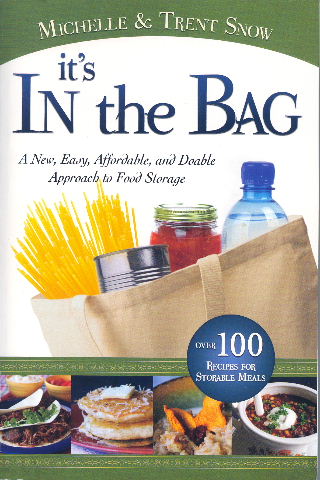
It’s In the Bag by Michelle and Trent Snow teaches a method for assembling a usable three-month supply of food. Its purpose is to promote daily self-reliant living through food storage (expanded rather than basic), canning, sprouting, raising chickens, and producing dairy products at home.
Recipes in It’s In the Bag list everything you need, including water, to prepare a complete meal (sometimes even the side dishes). Items are stored in medium size gift bags with the recipe attached to the outside. Each meal serves 6 to 8 people. Twelve advantages are given for storing your 3-month supply this way:
- You’ll have organized, complete meals you know your family will enjoy.
- Bag Meals save you time and money.
- Bag Meals have shorter prep time.
- Bag Meals will save you space.
- Bag Meals offer a sense of security when you know that you’ll always have all the ingredients for your meals.
- Anyone in your family who has basic reading skills can prepare a Bag Meal—even a husband who doesn’t cook.
- All ingredients found in Bag Meals are pre-measured.
- The Bag Meal System is an easy way to “baby step” your way to building food storage.
- It’s easy to rotate your food storage, and, best of all, you know exactly what to buy to replace your food storage ingredients.
- You are always prepared to share a meal at a moment’s notice.
- In times of disaster, you won’t be eating a granola bar and beef jerky. You will be enjoying a complete meal.
- Suppose you are asked to evacuate your home. Adults can comfortably carry a bag meal in each hand, and even a young child can carry a bag meal in their arms.
I reviewed all the recipes but haven’t actually tried any. Most, if not all, look like they would be good. Be sure to test them, though, before storing multiple bags of the same recipe. Here are some things to be aware of:
• There are about 60 main dish recipes. The rest (about 40) are breakfast recipes.
• There is at least one recipe that has crisp dry ingredients in the same bag as moist dry ingredients. I personally wouldn’t do that.
• There are quite a few convenience foods in the ingredients lists. These include rice pilaf mix, enchilada sauce mix, dried vegetables that must be specially obtained (celery, carrots, bell pepper), turkey gravy mix, canned cheese, sour cream and chive potatoes, canned butter, Pad Thai sauce, plum sauce, and enchilada sauce.
• Read the recipes carefully. The format is not consistent throughout and can be misleading and confusing sometimes.
• It’s not clear if the powdered milk is instant or regular.
• Some recipes require fresh eggs.
• The rice to water ratios differ between recipes.
• Powdered eggs are required for the pancakes and muffins.
• Bottled water can be expensive. Reuse bottles several times or just measure water out when you need it and don’t store it in the bag.
• Not every recipe would be better bagged, especially the breakfasts. Some are almost as fast to measure ingredients when preparing them and would save the space the bag takes up.
• Not all recipes are economical. Be careful!
One nice addition to some recipes is the optional fresh ingredients you can add or substitute.
The photographs in the book are black and white and don’t do justice to the food but are helpful in the bag instructions.
There are actually several more chapters after the Bag Meal ideas:
“Do-It-Yourself Dairy Recipes” – Instructions and recipes are given for ten homemade dairy products. They all must be made with fresh milk and not powdered, though.
“I Can; You Can; We All Can: Home Canning Basics” – Numerous recipes and instructions are given for home canning. PLEASE use the current USDA canning guide or the Ball Blue Book instead. One instruction continually given is to tighten the lids and rings firmly on the jars before processing. Please do NOT do that. They can buckle and cause seal failure. Tighten them only fingertip tight.
“Trent’s Sprouting Methods” – The recommendation is given to not store sprouting seeds in an oxygen free environment to avoid sprout failure. That is a common myth. Lack of oxygen in storage does not affect seed viability negatively. Trent does include instructions for a creative sprout jar drainer, though, if you’re handy and want to build your own.
“Chicken Coops and Eggleberries” – This chapter on chickens gives some information on egg storage, cutting up a chicken, and building a suburban chicken coop.
The last section lists equivalent measures, substitutions, and food weights and measures.
The Bag Meal system is a great way to have, use, and eat stored food. Once organized, it does save time, but if you have a list of recipes you always have ingredients for, it takes only a few minutes more to decide and prepare a meal and may save space in a space challenged home. I question whether the Bag Meal method actually saves space so I don’t know how practical this really is for someone who doesn’t have a large pantry, dedicated closet, or basement store room. I also believe there is danger in building your food storage entirely on expanded storage rather than basic storage but that’s a topic for a whole other article. In the meantime, check out “Why Basic Storage?”.
The Snows have also put together Gluten-Free Food Storage: It’s In the Bag. I haven’t read it but did glance through it. It appears to be exactly the same book as It’s In the Bag except that the recipes are gluten free.
